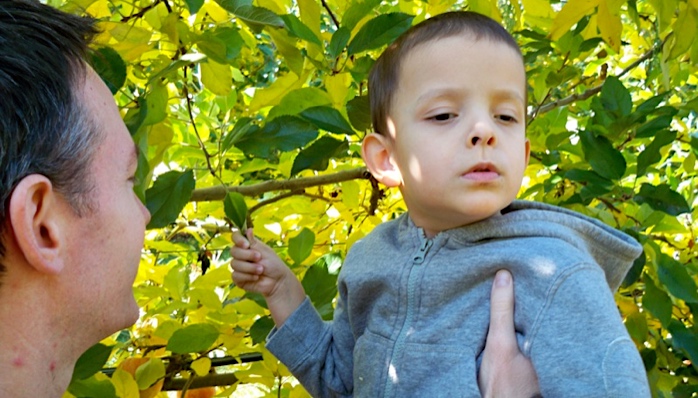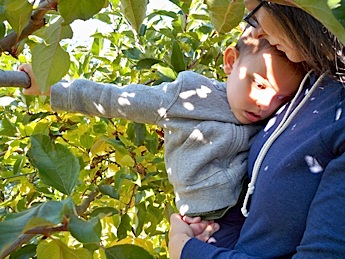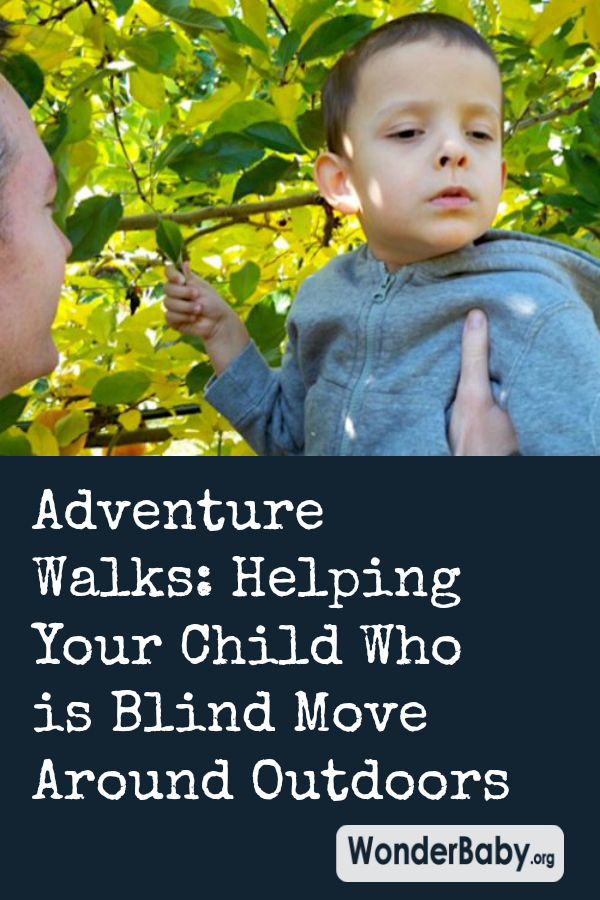Adventure Walks: Helping Your Child Who is Blind Move Around Outdoors

Adventure walks are outdoor explorations and field trips turned into learning opportunities.
Children who are blind or have low vision often miss important information about the world around them, especially in outdoor and public places. Helping them get “up close and personal” with these settings improves their understanding, increases language opportunities, and enriches social exchanges with family and friends.
A full memory bank of touching, hearing, smelling, and looking, outdoors and in their communities, will build important concepts for further classroom learning. Also, children who are blind increase their tactile tolerance and curiosity this way.
Children with low vision enjoy the same benefits, and expand their understanding of what they see, therefore improving their functional vision.
Let’s Go on an Adventure Walk!
-
- Get outdoors on a daily basis to explore, touch, smell, and look at a variety of natural and manmade items in the family yard, school yard, or playground: shrubs, flowers, trees, mailbox, bird feeder, sprinkler, family car, grass, sidewalk, gravel, mulch, play equipment, etc.
- Take your child on outings to parks, stores, and community events often, offering extra time to look, touch, name, and smell a huge variety of common items in these settings. Keep in mind that your child, with blindness or low vision, is probably unable to see in any detail most of what is around him. Even a child with relatively good vision, may only be able to recognize objects up to three feet away.
- Pick up your child or otherwise get her close to the object, providing the option of touching or not. Tell her what it is, touch it yourself, and make a natural sound with it if possible, giving lots of time to look and listen. Encourage her to touch objects that are safe. Repeat these walks often… regular exposure should increase interest and tolerance. Honor any hesitation shown by your child by moving away, but offer the same experience again soon.

- Use your child’s preferred mode of movement to explore outdoors, such as independent walking, guiding by the hand, carrying, or wheeling her in a wagon or chair. When possible bring your child to the object. If not, move your child as close as possible, and bring the object to her.
- Encourage your child who walks to move all over the yard or playground freely, while you follow closely to supervise and provide verbal interpretation of surfaces, sounds, and objects. Remind him to put his “hands out in front” just before contacting an obstacle. Let him contact obstacles with his hands, if safe to do so, instead of guiding him around them, telling him what he is about to touch.
- As your child explores the yard, school yard, or playground take note of what she especially enjoys and return to these locations and activities later. These may not always be the play equipment you have thoughtfully selected and set up! Instead, she may for a time prefer the puddle at the top of the driveway, scraping her feet in the gravel, turning on the garden hose, etc. Use whatever she loves the most to make movement and exploration outdoors meaningful and fun.
- For a child who is anxious, or not yet stable enough to walk well over the ground surface, provide Sighted Guide or hand-holding, while encouraging her to choose where to go. Over time encourage her to release your hand more and more. Walking over the less even surfaces outdoors increases balance and stability.
- A toddler will often plop into sitting when walking over the uneven outdoor surface. Allow this fall to happen if you know your child is not likely to get hurt, and then encourage him to stand back up without your help. This may require him to put his hands down on the surface (grass, mulch, sand, etc.) and push into standing, a good experience for upper body strengthening and increasing tactile awareness and tolerance.
- For infants and children who do not move independently provide a small blanket for sitting in the grass, sand, or mulch. Let your child find these along the edge of the blanket in his own time. It is fine for him to touch and then withdraw. Over repeated trials he is likely to begin moving to the new texture more and more, if he is not required to touch it.
- Our children often need extra motivation to play outdoors, since at first it may only represent an overwhelming collection of unfamiliar sensations (e.g., ground textures, air temperatures, animal, lawn care, and traffic sounds, and breezes against the skin). Repeated experiences with enjoyable activities and play items may give your child a reason to explore the outdoors. These might include a wading pool, play equipment, riding on Grandpa’s tractor, washing the dog, putting gravel in a pail, playing in the leaves, chasing a beach ball, pushing a cart or riding a wheeled vehicle in the driveway, walking to the car for each errand instead of being carried, etc.
- When setting up play equipment and wading pools consider locating them within a few feet of the door of the house or classroom, and leave them predictably positioned. If using 2 or 3 different pieces, position them with only 4 to 6 feet between each, and again leave them in the original arrangement. This way your child can be taught to how to move to the area, and then from one piece to another independently. Ask your O&M specialist for specific suggestions regarding the actual route and arrangement, and any safety concerns.
- Children who are light-sensitive (photophobic) can enjoy play outdoors also, with some simple precautions, such as hats with broad brims, sun-protecting eye shades, and play areas and activities conducted under shade trees and in the shadow of a building line. Your O&M specialist can help determine appropriate light protection, and offer suggestions about increasing your child’s tolerance for them.
Read this article in Arabic: قراءة هذا المقال بالعربية

Related Posts

Eye Conditions and Syndromes, Visual Impairment
Neuralink Announces Plans to Restore Sight to the Blind with Brain Chip
Elon Musk’s company Neuralink has announced plans to begin human trials of its new “Blindsight” brain chip by the end of 2025.

Visual Impairment
The Gift of Understanding: How a Young Child Helps His Blind Father Navigate Life
When a parent is blind, it’s natural for people to wonder how their sighted child will adapt. Will they struggle to understand their parent’s needs? Will they feel burdened by...

Braille and Literacy, Toys, Visual Impairment
24 Braille Toys for Kids Who are Blind
Everything from alphabet blocks to raised line coloring pages and activity books to puzzles to card and board games... and so much more! And it's all in braille ready for...